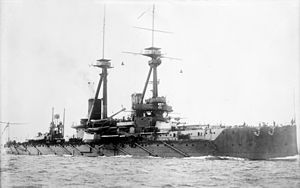 Bellerophon in 1909
| |
| Class overview | |
|---|---|
| Operators | |
| Preceded by | HMS Dreadnought |
| Succeeded by | St Vincent class |
| Built | 1906–1909 |
| In service | 1909–1921 |
| In commission | 1909–1921 |
| Completed | 3 |
| Scrapped | 3 |
| General characteristics (as built) | |
| Type | Dreadnought battleship |
| Displacement | 18,596 long tons (18,894 t) (normal) |
| Length | 526 ft (160.3 m) (o/a) |
| Beam | 82 ft 6 in (25.1 m) |
| Draught | 27 ft (8.2 m) |
| Installed power |
|
| Propulsion | 4 × shafts; 2 × steam turbine sets |
| Speed | 21 knots (39 km/h; 24 mph) |
| Range | 5,720 nmi (10,590 km; 6,580 mi) at 10 knots (19 km/h; 12 mph) |
| Complement | 680–840 |
| Armament |
|
| Armour | |
The Bellerophon-class battleship was a group of three dreadnought battleships that were built for the Royal Navy in the first decade of the 20th century. The sister ships spent most of their careers assigned to the Home and Grand Fleets. Aside from participating in the Battle of Jutland in May 1916, and the inconclusive action of 19 August several months later, their service during the First World War generally consisted of routine patrols and training in the North Sea.
In late 1918, Temeraire and Superb were transferred to the Mediterranean Fleet and supported Allied forces in the Mediterranean and the Black Sea after the war ended in November. The Bellerophons were deemed obsolete by this time and were reduced to reserve in 1919 and were then used as training ships. Superb was used for gunnery experiments in 1920 and then became a target ship in 1922 before being sold for scrap later that year. Bellerophon and Temeraire were sold in late 1921 and subsequently broken up.